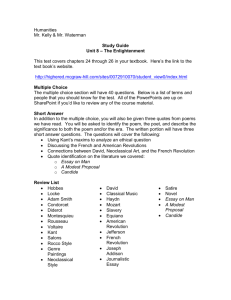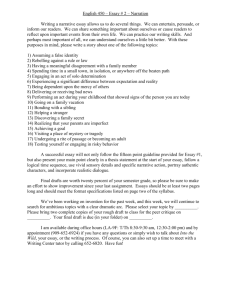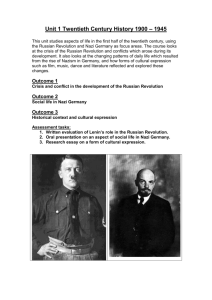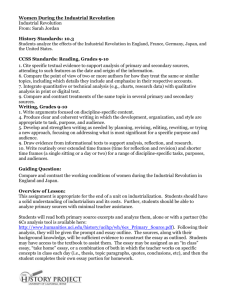ideas that shaped the russian revolution
advertisement
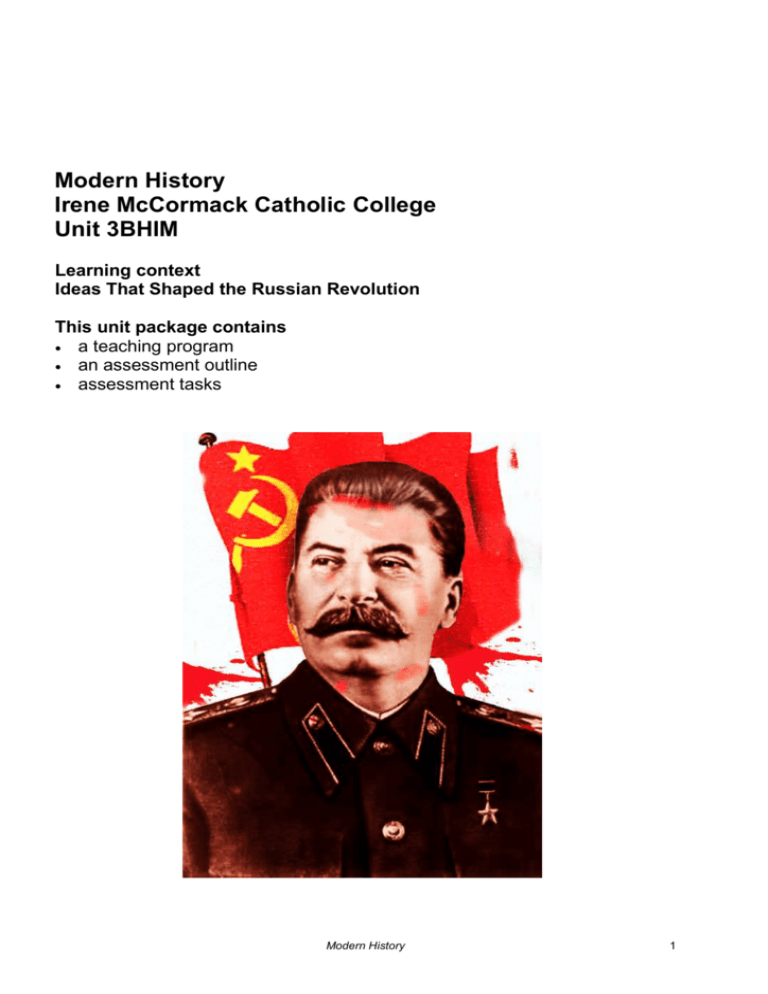
Modern History Irene McCormack Catholic College Unit 3BHIM Learning context Ideas That Shaped the Russian Revolution This unit package contains a teaching program an assessment outline assessment tasks Modern History 1 2 Modern History 3BHIM: Ideas That Shaped the Russian Revolution Week 1–2 3 Key activities/strategies Course requirements Introduction: geography, social structure, political structure Ideas: autocracy, liberalism, populism, socialism and Marxism Groups: nobility, intelligentsia, Social Democrats— Bolsheviks and Mensheviks (1903 Conference), Socialist Revolutionaries Individuals: Tsar Nicholas, Lenin 1900—1914: The liberal experiment 1905 ‘Revolution’, workers petition, Father Gapon 1906—1914: Dumas, Stolypin, the rise of the intelligentsia Lenin in exile 4–5 1914—1917: World War I and its impact Political discontent: Tsar as commander-in-chief, Tsarina and Rasputin, Progressive Bloc Economic discontent: winter of discontent 5–7 Revolutionary Ideals: the revolution from below versus the revolution from above February Revolution: Provisional Government and the Soviets Provisional Government, composition and Kerensky Soviets, Order #1 Bolsheviks—April Thesis, July Days, Milrevcom October Revolution: Boshevik Revolution Historical debate—was the Bolshevik seizure of power a coup d’etat or revolution? (Service, Read, Deutscher, Carr) 7–9 10 Putting ideas into practise: support and opposition Abolition of the Constituent Assembly, Decrees, State Socialism, Brest-Litovsk Treaty The elimination of class enemies Civil War: the role of Trotsky and the Red Army, War Communism: the role of Lenin and the Cheka Kronstadt Rebellion NEP—economic liberalisation and political repression Evaluation of Lenin/Leninism (Pipes, Figes etc.) Content Evolution and the spread of events and ideologies within and beyond a society Key influences on the emergence of prominent people, events and ideas within a society Relationship between historical forces of past events, individual motivations and actions How values, beliefs and traditions have been manipulated or used to reinforce dominant elements in society Similar and different perspectives are shaped by beliefs, ideas, philosophies and ethics across time and place Role of ideas and ideologies as forces for continuity and change in society Evolution and the spread of events and ideologies within and beyond a society Changing perspectives about past events can challenge accepted explanations and representations How history is constructed and recorded changes over time Changing political, economic and social circumstances of individuals and groups in a society over a time period Extent of impact and influence of people, events and ideas within and beyond the society How history is constructed and recorded changes over time Debates about the past reflect the nature, context, aims and purposes of historians and others Modern History Assessment Task 1: Document study Ideas that shaped the Russian Revolution Task 2: Document study Events that shaped the Russian Revolution Task 3: Explanation Key people, ideas and events over the period. Evaluation of Lenin and Leninism 3 Week 11–12 13 14 15 Key activities/strategies Content The Rise of Stalin Stalin before 1924 The death of Lenin NEP versus Industrialisation/Collectivisation Socialism in One Country versus Permanent Revolution Extent to which ideas, events and other influences were cohesive or divisive Stalin and the Great Turn Collectivisation and Famine 5 Year Plans and Industrialisation, Stakhanovites Relationship between structures of power and authority and its legitimacy Changing political, economic and social circumstances of individuals and groups in a society over a time period Extent to which ideas, events and other influences were cohesive or divisive Extent of impact and influence of people, events and ideas within and beyond the society How values, beliefs and traditions have been manipulated or used to reinforce dominant elements in society Changing and evolving perspectives of individuals over time influence the construction of conflicting or alternative explanations and representations of past people, events and ideas The Nature and style of Stalin’s leadership Class warfare—dekulakisation 1934—chistka, 17th Party Congress, Stalin and Kirov 1936 Constitution, Show Trials The Yezhovshchina Evaluation of Stalin 4 Modern History Assessment Task 4A and 4B: Historical inquiry consequences of continuity and change over the period– an evaluation of Stalin Sample assessment outline for Unit 3BHIM Ideas that shaped history—The Russian Revolution Type weighting 20% Task weighting Outcome 1 Historical investigation and participation Outcome 2 Understanding the past Outcome 3 Continuity and change Outcome 4 Interpretations and perspectives 20% 15% Task 4B In-class verification essay— Stalinism and its impact 10% Task 1 Document study In-class Document study: Ideas that shaped the Russian Revolution 10% 15% 30% Task Task 4A Historical inquiry Stalinism and its impact Task 3 Explanation In-class unseen essay without notes 25% 25% 30% Task 2 In-class Document study—Events that shaped the Russian Revolution Task 5 Exam A written exam of 3 hours. The exam will consist of: two document studies two essays. Modern History 5 3BHIM—Ideas that shaped history Type: Document study Outcomes: Outcome 1: Historical investigation, communication and participation; Outcome 2: Understanding the past; Outcome 4: Interpretations and perspectives Unit content: Historical thinking and methodology; Working with historical narrative Historical explanation and representation TASK 1: In-class document study. Read the documents then respond to the questions provided. The questions are the same as those in the WACE exam. Time for the task 5 minutes reading time and 45 minutes writing time. What you need to do Analyse the documents and answer the questions. This task is worth 10% of your unit mark. What needs to be submitted for assessment? □ Responses to the questions See next pages for sources and questions. 6 Modern History Due dates: TASK 1: Document study 1—Ideas that shaped the Russian revolution Source 1 We, the Socialist-Revolutionaries, ceaselessly call on the people to struggle for the people's cause. We do so by word and by example. We invite into our ranks everybody who no longer wishes to wait, but who wants to win land and freedom for the people. Down with the autocracy! We demand that elected representatives of the whole country should consider and decide upon the reconstruction of all our institutions in the interests of the working people. We demand the convocation of a Constituent Assembly! Down with arbitrariness and violence! We demand full freedom of conscience, speech, the press, assembly, trade unions and strikes! We demand the repeal of all laws which restrict the rights of those nationalities forcibly imprisoned in the Russian Tsardom. Down with the unaccountable bureaucracy! We demand that all in responsible positions be elected, removable and answerable before the courts! Down with the landowners! We demand an end to the trade in our mother earth, and demand that all land pass into the control and use of the whole working agricultural population! Down with the capitalists! We demand that everything created by the labour of the working people should pass to them, should be for the common benefit, and should not go into the pockets of a bunch of useless layabouts! Down with the war! We demand peace and fraternity between the peoples, we demand that every people have the right freely to decide its own fate, we demand general disarmament and the replacement of standing armies by a people's militia. We demand an immediate end to this terrible, destructive and bloody war with Japan, of no use to the working people! Comrades! The struggle continues! In struggle we will find our rights! The Central Committee of the Party of Socialist-Revolutionaries! July 1904 [From: King, F. (Trans.). (2002). History of the Soviet Union: The Socialist-Revolutionaries' assassination of Interior Minister von Plehve, July 1904. Retrieved September, 2009, from University of East Anglia website: www.uea.ac.uk/his/webcours/russia/documents/plehve1.shtml] Source 2A The traditional view of the Social Democrats concerning the peasantry, following that of Marx and Engels, held that … it was a reactionary class. However, observing the behavior of Russian peasants during the agrarian disturbances of 1902 and even more in 1905 and noting the contribution which their assaults on the landlord property had made to the capitulation of tsarism, Lenin concluded that the muzhik were a natural, if transitory, ally of the industrial worker… The Bolshevik program came out in favor of nationalizing all the land, private as well as communal, and transferring the cultivation to the peasants. [From: Pipes, R. (1990). The Russian Revolution. New York: Random House, p. 367] Modern History 7 Source 2B The educated and economically advanced elements of Russia’s population which clamoured for political rights was a visible but small minority. The main concern of the Imperial administration was the fifty million Great Russian peasants concentrated in the central provinces, for it was on their tranquility and loyalty that the internal security of the Empire ultimately depended. The peasant had grievances but they were not political: he could no more imagine a different system of government than a different climate. The existing regime suited him well because he could understand it from his personal experience in the peasant household, which was organized on the same model … [From: Pipes, R. (1990). The Russian Revolution. New York: Random House, pp. 55–56] Questions A) Compare and contrast the messages conveyed by Source 1 and Source 2. (6 marks) B) Explain the historical context of Source 1 and Source 2—that is the relevant events, people and ideas depicted or represented in the sources. (6 marks) C) Account for the different perspectives presented in Source 1 and Source 2. Your answer may include discussion of purpose, motive, place and time. (6 marks) D) Using your knowledge of the period up to 1917, evaluate the importance of the ideas, issues and/or events represented in the two sources. (7 marks) 8 Modern History Suggested generic marking guide for the Document study A) Compare and contrast the messages conveyed by Source 1 and Source 2. (6 marks) points of comparison of the message/s in Source 1 and Source 2 points of contrast of the message/s in Source 1 and Source 2 reference to relevant supporting evidence from the sources B) Explain the historical context of Source 1 and Source 2—that is the relevant events, people and ideas depicted or represented in the sources. (6 marks) relevant events depicted/represented and/or relevant people depicted/represented and/or relevant actions depicted/represented reference to the relationship of the events/people/actions within the broader historical context reference to relevant supporting evidence from the sources and to the time period C) Examine the issues involved in interpreting the historical evidence of Source 1 and Source 2. Your answer may include discussion of purpose; motive; place; and time. (6 marks) identify the issues of interpretation in Source 1—this may include a discussion of: purpose; motive; place; time and/or validity identify the issues of interpretation in Source 2—this may include a discussion of: purpose; motive; place; time and/or validity reference to relevant supporting evidence from the sources for top marks, students need to bring the answer together showing an understanding of the different issues involved D) Using your knowledge of the whole period, evaluate the importance of the ideas, issues and/or events represented in the two sources. (7 marks) identification of the ideas/issues/events placement of the ideas/issues/events with the ideas/issues/events of the broader historical context of the time. Students should be able to demonstrate a depth and breadth of knowledge of the relevant time period evaluation of the importance of ideas/issues/events in relation to those of the broader historical context. To obtain top marks for this evaluation, students would have to compare/contrast what is in the sources with the other ideas/issues/events of the time students may refer to the historical debate on the ideas/issues/events raised in the sources Modern History 9 3BHIM—Ideas that shaped history Type: Document study Outcomes: Outcome 1: Historical investigation, communication and participation; Outcome 2: Understanding the past; Outcome 4: Interpretations and perspectives Unit content: Historical thinking and methodology; Working with historical narrative Historical explanation and representation TASK 2: In-class document study. Read the documents then respond to the questions provided. The questions are the same as those in the WACE exam. Time for the task 5 minutes reading time and 45 minutes writing time. What you need to do Analyse the documents and answer the questions. This task is worth 15% of your unit mark. What needs to be submitted for assessment? □ Responses to the questions See next pages for sources and questions. 10 Modern History Due dates: TASK 2: Document study 2—Events that shaped the Russian Revolution Source 1 This poster celebrates the first anniversary of the revolution and was produced by the Central Executive Committee For copyright reasons this poster cannot be reproduced in the online version of this document, but may be viewed at http://zmier.iatp.by/plakat/1918/Apsit-b.jpg [Alexander Apsit, 1918. David King Collection www.davidkingcollection.com/ In Allan, P.D. (1983). Russia and eastern Europe. London: Edward Arnold, p. 25)] Modern History 11 Source 2 One of the basic misconceptions of the Russian Revolution is that the Bolsheviks were swept to power in a tide of mass support for the party itself. The October insurrection was a coup d’etat, actively supported by a small minority of the population (and indeed opposed by several of the Bolshevik leaders themselves). But it took place amidst a social revolution, which was centred on the popular realization of Soviet power … as the direct self-rule of the people … The political vacuum brought about by this social revolution enabled the Bolsheviks to seize power in the cities … The slogan ‘All Power to the Soviets!’ was a useful tool, a banner of popular legitimisation covering the nakedness of Lenin’s ambition … Later, as the nature of the Bolshevik dictatorship became apparent, the party faced the growing opposition of precisely those groups in society who had rallied behind the soviet slogan. [Adapted from: Figes, O. (1997). A People’s Tragedy: The Russian Revolution 1891–1924. London: Pimlico. © Eva Figes Reproduced by permission of the author c/o Rodgers, Coleridge & White Ltd.] Questions A) Compare and contrast the messages conveyed by Source 1 and Source 2. (6 marks) B) Explain the historical context of Source 1 and Source 2—that is the relevant events, people and ideas depicted or represented in the sources. (6 marks) C) Account for the different perspectives presented in Source 1 and Source 2. Your answer may include discussion of purpose, motive, place and time. (6 marks) D) Using your knowledge of the period up to 1917, evaluate the importance of the ideas, issues and/or events represented in the two sources. (7 marks) 12 Modern History Suggested generic marking guide for the Document study A) Compare and contrast the messages conveyed by Source 1 and Source 2. (6 marks) points of comparison of the message/s in Source 1 and Source 2 points of contrast of the message/s in Source 1 and Source 2 reference to relevant supporting evidence from the sources B) Explain the historical context of Source 1 and Source 2—that is the relevant events, people and ideas depicted or represented in the sources. (6 marks) relevant events depicted/represented and/or relevant people depicted/represented and/or relevant actions depicted/represented reference to the relationship of the events/people/actions within the broader historical context reference to relevant supporting evidence from the sources and to the time period C) Examine the issues involved in interpreting the historical evidence of Source 1 and Source 2. Your answer may include discussion of purpose; motive; place; and time. (6 marks) identify the issues of interpretation in Source 1—this may include a discussion of: purpose; motive; place; time and/or validity identify the issues of interpretation in Source 2—this may include a discussion of: purpose; motive; place; time and/or validity reference to relevant supporting evidence from the sources for top marks, students need to bring the answer together showing an understanding of the different issues involved D) Using your knowledge of the whole period, evaluate the importance of the ideas, issues and/or events represented in the two sources. (7 marks) identification of the ideas/issues/events placement of the ideas/issues/events with the ideas/issues/events of the broader historical context of the time. Students should be able to demonstrate a depth and breadth of knowledge of the relevant time period evaluation of the importance of ideas/issues/events in relation to those of the broader historical context. To obtain top marks for this evaluation, students would have to compare/contrast what is in the sources with the other ideas/issues/events of the time students may refer to the historical debate on the ideas/issues/events raised in the sources Modern History 13 3BHIM—Ideas that shaped history Type: Explanation Outcomes: Outcome 2: Understanding the past; Outcome 3: Continuity and change; Outcome 4: Interpretations and perspectives Unit content: Historical thinking and methodology; Working with historical narrative; Historical explanation and representation TASK 3: Explanation Write an in-class essay in which you respond to an unseen question that addresses the following: Assess the impact and influence of Lenin up to 1924. No notes are permitted. Time for the task 50 minutes. What you need to do Write a formal essay in which you develop an hypothesis about the importance of Lenin and support this hypothesis using the following points: identify the key ideas and actions of Lenin up to 1924 discuss the impact of these ideas and actions assess the influence of Leninism discuss the different representations of the importance of Lenin. This task is worth 15% of your unit mark. What needs to be submitted for assessment? □ Due dates: The completed essay Note to teachers: It is expected that markers would assign marks holistically. Markers could use the criteria on the following page to assist them in assigning a range of marks. 14 Modern History GUIDE TO MARKING RESPONSES Marks Introduction /3 Introductory paragraph comprising some context relevant to the area/topic of the essay, definition of any terms in the question, a proposition/thesis statement and an outline of the narrative/thematic structure of essay. A few sentences outlining the theme of the essay and including a simple proposition. A sentence or two outlining the ‘who’ or ‘what’ to be discussed in the essay. No introduction to essay provided 3 Understanding of Historical Narrative Demonstrates an understanding of the complexity of the inter-relationship between events, people and ideas, and continuity and change. Demonstrates an understanding of the narrative, for example that there are relationships between events, people and ideas, and/or continuity and change. A mainly chronological narrative with some content about, for example, events, people and ideas, and/or continuity and change. A simple narrative, not always showing an understanding of the correct chronology and with minimal reference to events, people and ideas. Response suggests no understanding of the chronology nor the narrative Complexity of analysis/argument 2 1 0 /4 4 3 2 1 0 /6 Displays a high level of sophistication in the construction, development and depth of an argument or analysis, including the complexity of the narrative. Maintains a sustained argument throughout the essay that demonstrates a high level of analytical skill and an understanding of the interconnectedness of the narrative. A simple chronological narrative with minimal content about the changing circumstances leading to continuity and/or change. Discussion/argument suggests no understanding of the topic and/or historic analysis of changing circumstance or continuity and change. Evidence used to support historical narrative and argument/analysis Detailed, accurate and relevant evidence used in a manner that assists critical analysis and evaluation. In responding to an essay instruction of debate or evaluate the proposition, historical evidence is used to argue for and against a view/proposition. Uses and cites accurately some quotations, or sources, or statistics, to develop or strengthen arguments. Use of detailed, accurate and relevant evidence throughout the essay. If quotations, sources, statistics are used as supporting evidence, they are cited in some coherent fashion. Mainly accurate evidence is used to support some lines of argument. Evidence is used, some is accurate, but there are generalisations in the essay. Limited evidence used and the response contains a number of generalisations and statements that lack supporting evidence. Very limited use of evidence and the response is mainly a series of generalisations. No supporting evidence, OR All evidence is incorrect. 5–6 3–4 1–2 0 /8 7–8 5–6 4 3 2 1 0 Conclusion /2 Draws essay’s argument or point of view together. Very superficial conclusion, or vaguely summarises with use of clichés such as ‘In conclusion...’ or one that just repeats the proposition stated in the introduction. No conclusion given. [2] [1] Communication skills /2 A well-written and well constructed argument using appropriate language of history. Sound use of the conventions except where expression is enhanced by defying conventions. Has some relevant use of historical terms, but is unable to express ideas with clarity of meaning. Response is mainly unable to be understood by the marker. 2 TOTAL 0 1 0 /25 Modern History 15 3BHIM—Ideas that shaped history Type: Historical inquiry Outcomes: Outcome 1: Historical investigation, communication and participation; Outcome 2: Understanding the past; Outcome 3: Continuity and change; Outcome 4: Interpretations and perspectives Unit content: Historical thinking and methodology; Working with historical narrative; Historical explanation and representation TASK 4A: Historical inquiry Investigate the impact and influence of Stalin on Russia 1928–1941. Using a variety of source materials develop a hypothesis using different historical perspectives as support. Present your hypothesis with supporting evidence on a retrieval chart or mind-map. TASK 4B: In-class verification essay–Stalinism and its impact Write a verification essay in class. TASK 4A Time for the task Three weeks of both class and your own time. What you need to do Historical thinking and methodology devise an Inquiry proposal and hypothesis select appropriate and relevant sources which show a variety of perspectives and interpretations select and annotate five sources, at least two of which must be primary sources devise a range of focus questions to enable you to address the hypothesis use an appropriate retrieval and/or note-making chart to record findings identify possible alternative interpretations from the evidence compile a correctly formatted bibliography. Working with historical narrative Show your understanding of the key people, ideas and events over the time period AND the consequences for continuity and change: evolution and the spread of events and ideologies within and beyond a society relationship between structures of power and authority and its legitimacy changing political, economic and social circumstances of individuals and groups in a society over a time period extent to which ideas, events and other influences were cohesive or divisive extent of impact and influence of people, events and ideas within and beyond the society how values, beliefs and traditions have been manipulated or used to reinforce dominant elements in society. Historical explanation and interpretation show that a range of perspectives exist and leads to historical debate. for each of the five key sources (see point 3) identify the message, tone, evidence of bias, purpose and usefulness. This task is worth 20% of your unit mark. 16 Modern History What needs to be submitted for assessment? □ Proposal, hypothesis and focus questions □ Retrieval and/or note-making chart □ Annotated sources including possible alternative interpretations □ A correctly formatted bibliography Modern History Due dates: 17 TASK 4A—SUGGESTED MARKING GUIDE Inquiry Description of what will determine your mark Marks available /10 Annotated sources A range of sources (e.g. primary and secondary; government documents; cartoons; literary; newspaper articles etc.) showing different perspectives of the impact and influence of Stalin. Focus questions and hypothesis A series of focus questions which illustrate the way you will interrogate the hypothesis. /5 Note-making An agreed note-making format. /3 Retrieval chart/Mindmap Ability to find and synthesise the main points in various resources according to key themes. /5 Bibliography Submission of a correctly formatted bibliography. /2 Total Teacher comment /25 18 Modern History TASK 4B Time for the task 45 minutes. What you need to do Write an essay, based on your research material, in which you consider the impact and influence of Stalin on Russia 1928–1941. You need to: state your hypothesis identify and discuss the key features of Stalin’s regime discuss the impact of Stalinism consider possible alternative interpretations of Stalin’s impact and influence give a reasoned and supported conclusion which recognises the alternative interpretations of Stalin’s influence on Russia during the period. This task is worth 10% of your unit mark What needs to be submitted for assessment? □ Due dates: The completed essay Note to teachers: It is expected that markers would assign marks holistically using the criteria on the following page to assist them in assigning a range of marks. Modern History 19 GUIDE TO MARKING RESPONSES Marks Introduction /3 Introductory paragraph comprising some context relevant to the area/topic of the essay, definition of any terms in the question, a proposition/thesis statement and an outline of the narrative/thematic structure of essay. A few sentences outlining the theme of the essay and including a simple proposition. A sentence or two outlining the ‘who’ or ‘what’ to be discussed in the essay. No introduction to essay provided 3 Understanding of Historical Narrative Demonstrates an understanding of the complexity of the inter-relationship between events, people and ideas, and continuity and change. Demonstrates an understanding of the narrative, for example that there are relationships between events, people and ideas, and/or continuity and change. A mainly chronological narrative with some content about, for example, events, people and ideas, and/or continuity and change. A simple narrative, not always showing an understanding of the correct chronology and with minimal reference to events, people and ideas. Response suggests no understanding of the chronology nor the narrative Complexity of analysis/argument 2 1 0 /4 4 3 2 1 0 /6 Displays a high level of sophistication in the construction, development and depth of an argument or analysis, including the complexity of the narrative. Maintains a sustained argument throughout the essay that demonstrates a high level of analytical skill and an understanding of the interconnectedness of the narrative. A simple chronological narrative with minimal content about the changing circumstances leading to continuity and/or change. Discussion/argument suggests no understanding of the topic and/or historic analysis of changing circumstance or continuity and change. Evidence used to support historical narrative and argument/analysis Detailed, accurate and relevant evidence used in a manner that assists critical analysis and evaluation. In responding to an essay instruction of debate or evaluate the proposition, historical evidence is used to argue for and against a view/proposition. Uses and cites accurately some quotations, or sources, or statistics, to develop or strengthen arguments. Use of detailed, accurate and relevant evidence throughout the essay. If quotations, sources, statistics are used as supporting evidence, they are cited in some coherent fashion. Mainly accurate evidence is used to support some lines of argument. Evidence is used, some is accurate, but there are generalisations in the essay. Limited evidence used and the response contains a number of generalisations and statements that lack supporting evidence. Very limited use of evidence and the response is mainly a series of generalisations. No supporting evidence, OR All evidence is incorrect. 5–6 3–4 1–2 0 /8 7–8 5–6 4 3 2 1 0 Conclusion /2 Draws essay’s argument or point of view together. Very superficial conclusion, or vaguely summarises with use of clichés such as ‘In conclusion...’ or one that just repeats the proposition stated in the introduction. No conclusion given. [2] [1] Communication skills /2 A well-written and well constructed argument using appropriate language of history. Sound use of the conventions except where expression is enhanced by defying conventions. Has some relevant use of historical terms, but is unable to express ideas with clarity of meaning. Response is mainly unable to be understood by the marker. 2 TOTAL 20 0 1 0 /25 Modern History REFERENCES Student text Corin, C and Fiehn, T (2002) Communist Russia Under Lenin and Stalin, London, John Murray Teacher references Figes, O. (1996) A People's Tragedy: The Russian Revolution 1891 - 1924, Pimlico Fitzpatrick, S. (1999) Everyday Stalinism, Oxford University Press Kotkin, S (1995) Magnetic Mountain: Stalinism as a Civilisation, University of California Press Pipes, R. (1990) The Russian Revolution, Random House Pipes, R. (1994) Russia Under the Bolshevik Regime, 1919 - 24, Harvill Press Reed, J. (1919) Ten Days that Shook the World Penguin Tucker, R.C. (1977) Stalinism: Essays in Historical Interpretation, Norton NOTE: The resources or references such as texts and websites in this document are provided as examples of resources that teachers can use to support their teaching. Their inclusion does not imply that they are mandatory, preferred or that they are the only resources relevant to the course. Modern History 21

